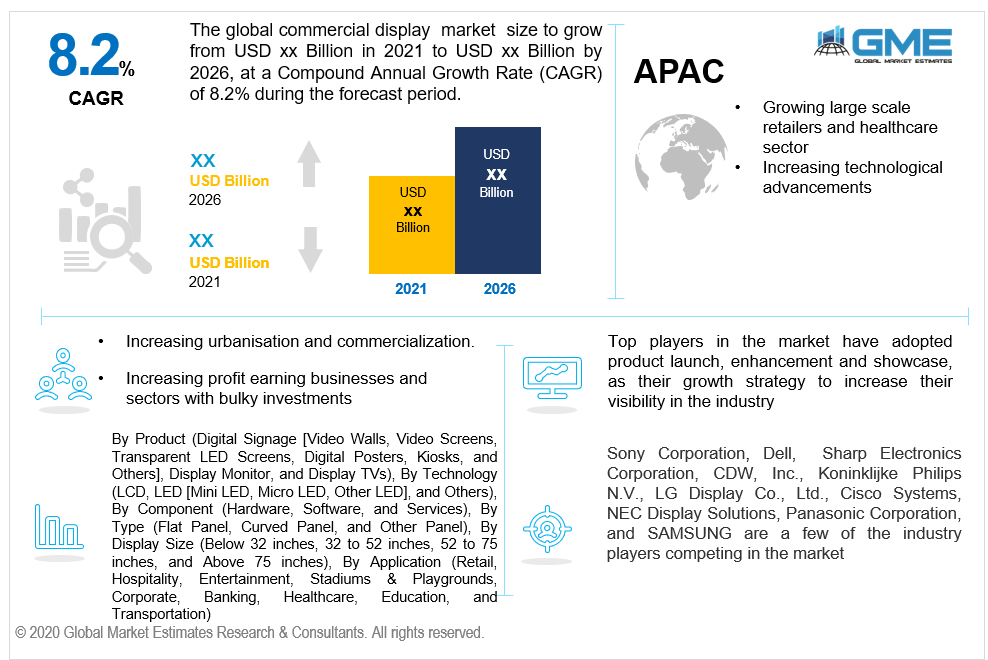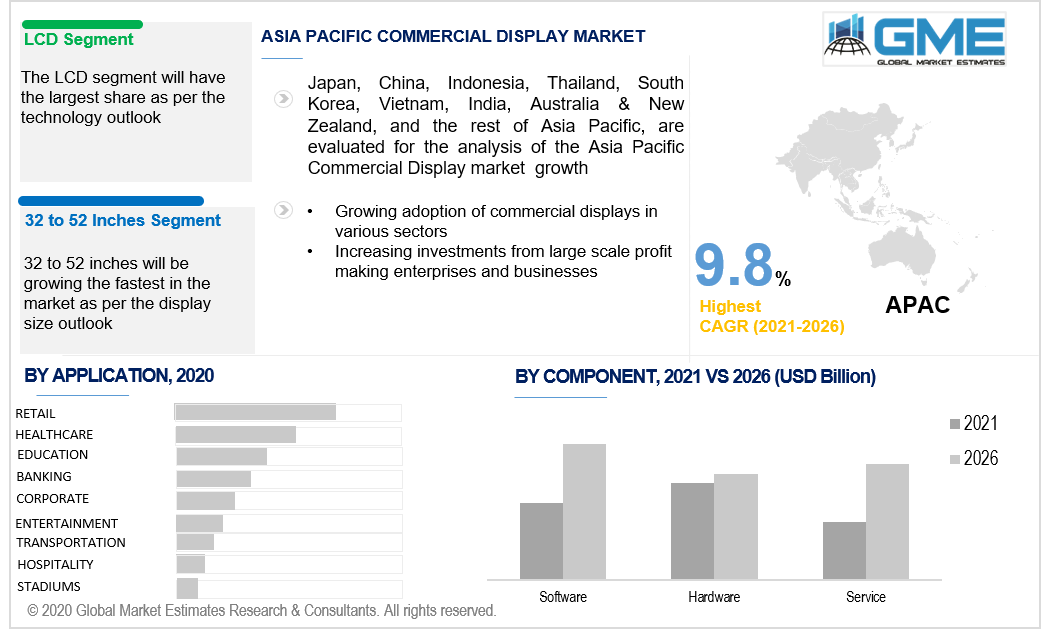
Global Commercial Display Market Size, Trends, and Analysis - Forecasts to 2026 By Product (Digital Signage [Video Walls, Video Screens, Transparent LED Screens, Digital Posters, Kiosks, and Others], Display Monitor, and Display TVs), By Technology (LCD, LED [Mini LED, Micro LED, Other LED], and Others), By Component (Hardware, Software, and Services), By Type (Flat Panel, Curved Panel, and Other Panel), By Display Size (Below 32 inches, 32 to 52 inches, 52 to 75 inches, and Above 75 inches), By Application (Retail, Hospitality, Entertainment, Stadiums & Playgrounds, Corporate, Banking, Healthcare, Education, and Transportation), Competitive Landscape, Company Market Share Analysis, and Competitor Analysis
Today, with increasing urbanization and commercialization, the demand for commercial displays in various verticals is becoming extremely popular. Especially in recent years, due to drastic technological transformations and a growing global economy, various businesses and sectors are flourishing. These flourishing and profit-earning businesses and sectors have been the most significant contributors to the growth of the commercial display market. Also, in the commercial sector, the component of marketing has become very crucial, and these commercial display sets make it easy for businesses or various commercial end-users to use these digital displays to attract customers’ and clients’ attention. With increasing infrastructural changes, the demand for massive-sized commercial displays is gaining attention among the verticals like retail shops or fashion outlets. The commercial digital displays enable these retailers and other sales outlets to showcase their products and advertise them on a bigger screen as compared to the consumer displays, thus gaining a more extensive consumer base and boosting the growth in the commercial display market as well. Businesses across various sectors require these commercial displays for a longer duration within the span of daytime compared to the consumer displays used in the home environment for few hours for entertainment purposes. Surveys have shown that these commercial businesses have a run time of a minimum of 12 hours, and they require display sets that can sustain for long durations. Commercial displays are being manufactured to sustain for a long duration, thus accelerating the demand from a diverse scale of businesses and enterprises. Compared to the consumer displays, commercial-grade displays facilitate brighter and better screening alternatives, attracting more commercial businesses to use these to entice customers. Besides advertising or marketing purposes, huge commercial classes, or offices, utilize these commercial displays in their conference rooms to display important presentations or reach out to the students with better display qualities and HD graphics. Also, today, with such a massive response for commercial displays from various verticals, the manufacturers of these commercial display sets are getting an opportunity to bring various advanced features and automized commercial displays, which are thus accelerating growth in the commercial display market.

Based on the product type, the commercial display market is divided into digital signage, display monitor, display TVs. Digital signage has the largest share and dominates the market with its favorable features like the ability to customize eye-catchy and attention-grabbing displays. These digital signage products are more cost-effective than most commercial display products. These digital signages are also available for the commercial users in various types namelyvideo walls, video screens, transparent led screens, digital posters, kiosks, and others, which provide diversity and variability to the merchants to utilize those displays which suit their requirement, thus enhancing the growth within the market.
Also, increasing commercialized schools and colleges with tremendous incorporation of digitalized education techniques are gradually increasing the demand for digital monitors. Digital monitors are expected to witness the fastest growth within the market, especially during the forecast period, because of the transforming education system, corporate finance, and banking sectors.
The commercial display market is divided into LED and LCD categories depending on the technologies used.Amongst these, LCD was being drastically utilized for these commercial displays across all the applications. As of 2018-2019, LCD held the largest share in the commercial display market. However, today, and within the forecast period, the LED-based commercial display products are expected to overtake the share of LCDs and dominate the market. Major commercial businesses utilize commercial displays for longer durations, and consuming higher electricity rates can become costlier for the businesses, although LED products utilize considerably less power, thus being a cost-effective alternative over the LCD products. Surveys have shown that LED products enabled users to cut down their power costs by approximately 50 percent. Also, the quality of display and sharpness are much better in LED commercial displays, making them more preferred within the market.
The commercial display market is classified into three categories depending on their components: hardware, applications, and services.The hardware segment had its dominance in the market till recent years, owing to its ability to facilitate manual control over the operations, easy cabling, and installation. However, today, with increased advancements and cloud-based or on-premise deployments, the demand for software increases exponentially in the market. The software segment is expected to witness the fastest growth in the commercial display market and is expected to surpass the share of the hardware segment during the forecast period owing to the rising automatization, digitalization, and increased demand for digital signage. Also, the service segment is gradually experiencing a boom as well in its demand and growth. With such complex and advanced commercial displays, the demand for services that facilitate installation and connectivity of these screens within the infrastructure and make their operation easy is increasing.
Based on the type, the commercial display market is segmented into a flat panel, curved panel, and other panels. The demand for flat panels has been experiencing an upward trend in the marketfor many years. These flat panels hold the majority of the share in the commercial display market. The increased demand for digital signage, LED screens, cost-effective alternatives, better display quality, and warrantee, with fewer connection complexities, make the flat panels more preferred and demanded within the commercial display market than the rest of the display types.
The commercial display market is divided into four categories depending on screen size: below 32 inches, 32 to 52 inches, 52 to 75 inches, and above 75 inches.Amongst these, 32 to 52 inches commercial display screens are majorly demanded and have relatively large shares in the market. This particular range of display size suits the requirements of the majority of commercial businesses, retailers, or even for educational purposes in private schools. These provide better display quality that is appropriate for medium to large-scale commercial enterprises, thus accelerating the demand and growth within the commercial display market. However, a substantial number of commercial businesses with massive investments are gradually demanding display screens of above 75-inch sizes. These are becoming the new normal within the commercial sector, thus, becoming new marketing and advertising strategies and attracting a massive consumer base.
Depending on the applications, the commercial display market is categorizedasretail, hospitality, entertainment, stadiums & playgrounds, corporate, banking, healthcare, education, and transportation. The retail segment holds the largest share in the commercial display market. Several retailers like Walmart, Target, Cosco, and many others operating in different sectors utilize commercial displays to advertise their sales, discounts, and offers, thus attracting the consumers’ attention. Installing these commercial displays is the new advertising technique to reach out to a more extensive consumer base. The customization feature facilitated by these commercial displays also enables the retailers to bring out attention-grabbing digital advertisements and displays, thus boosting their profit and accelerating the growth within the commercial display market.

Based on the regional segmentation, the commercial display market is led by North America. The countries in the North American region contribute significantly to their large share in the global market. Countries like the United States and Canada have some of the world's biggest retailers, and these countries are also some of the biggest manufacturers of commercial displays. Within the forecast timeframe of 2021-2026, the Asia Pacific region is projected to experience massive growth.The countries in the APAC region are undergoing technological transformations, which are boosting the demand for commercial displays in the market. Also, these countries have significant healthcare, retail, education, and banking sectors, requiring better quality and performance-based commercial displays. Besides these factors, these countries are a massive, lucrative space full of opportunities, demand, and scope that encourage new emerging manufacturers to make investments in the APAC region.
Sony Corporation, Dell, Sharp Electronics Corporation, CDW, Inc., Koninklijke Philips N.V., LG Display Co., Ltd., Cisco Systems, NEC Display Solutions, Panasonic Corporation, and SAMSUNG are a few of the industry players competing in the commercial display market.
Please note: This is not an exhaustive list of companies profiled in the report.
We value your investment and offer free customization with every report to fulfil your exact research needs.
The Global Commercial Display Market has been studied from the year 2019 till 2026. However, the CAGR provided in the report is from the year 2021 to 2026. The research methodology involved three stages: Desk research, Primary research, and Analysis & Output from the entire research process.

The desk research involved a robust background study which meant referring to paid and unpaid databases to understand the market dynamics; mapping contracts from press releases; identifying the key players in the market, studying their product portfolio, competition level, annual reports/SEC filings & investor presentations; and learning the demand and supply-side analysis for the Commercial Display Market.

The primary research activity included telephonic conversations with more than 50 tier 1 industry consultants, distributors, and end-use product manufacturers.

Finally, based on the above thorough research process, an in-depth analysis was carried out considering the following aspects: market attractiveness, current & future market trends, market share analysis, SWOT analysis of the company and customer analytics.

Tailor made solutions just for you
80% of our clients seek made-to-order reports. How do you want us to tailor yours?
OUR CLIENTS